必修3 unit2 教案[下学期]
图片预览
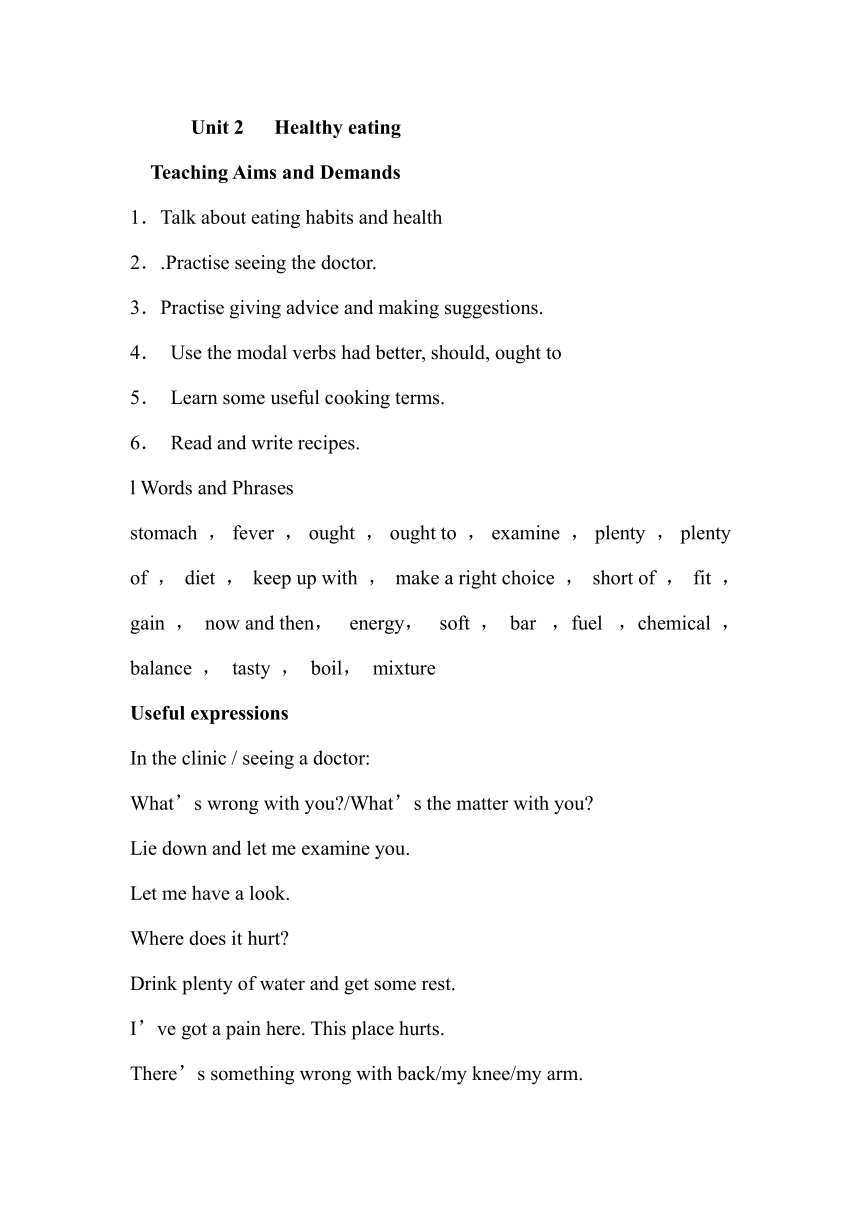
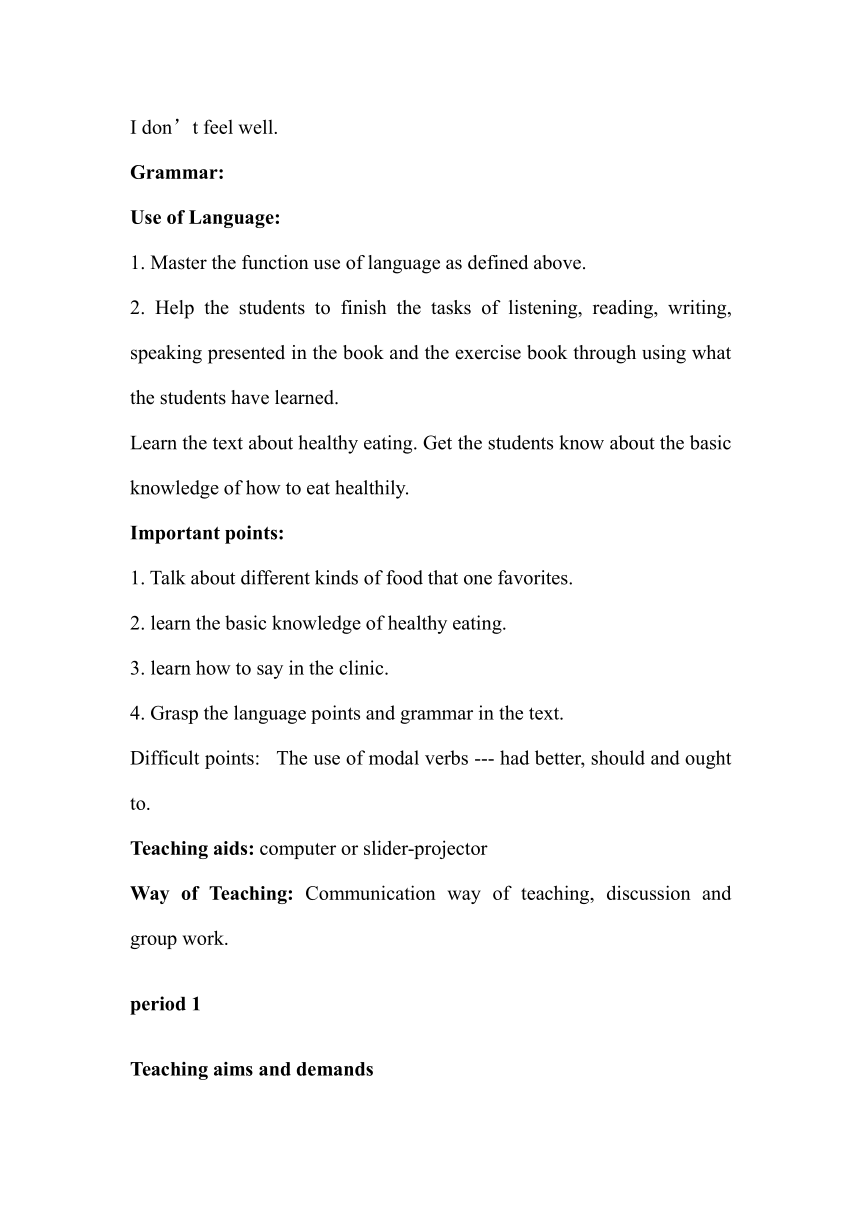
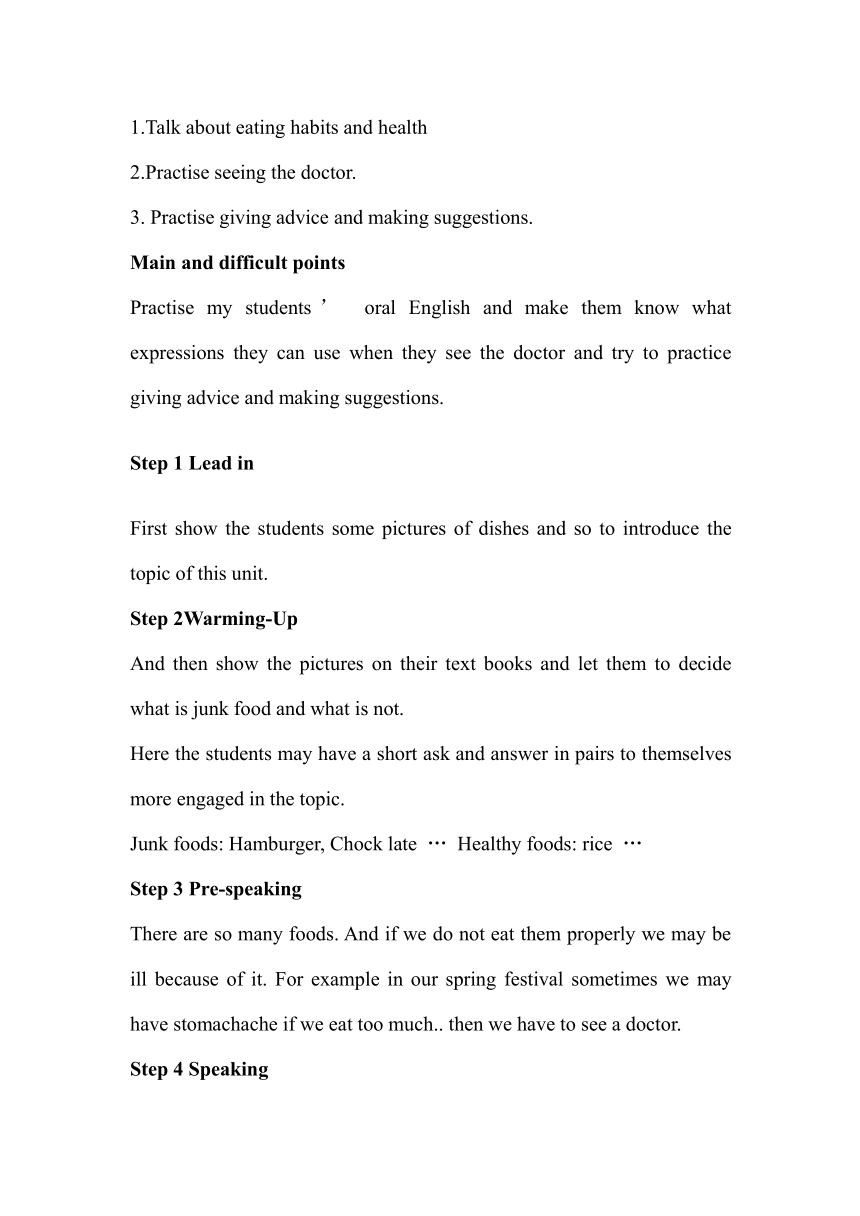
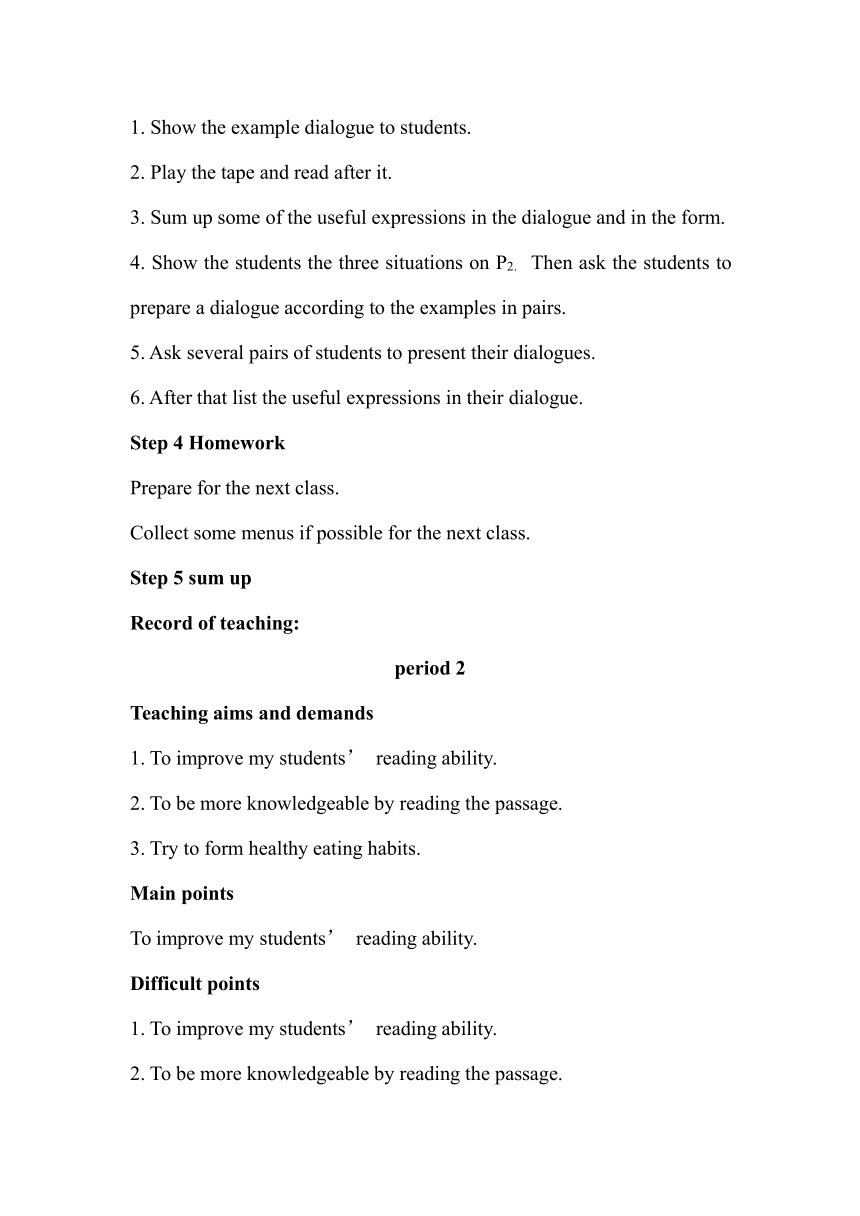
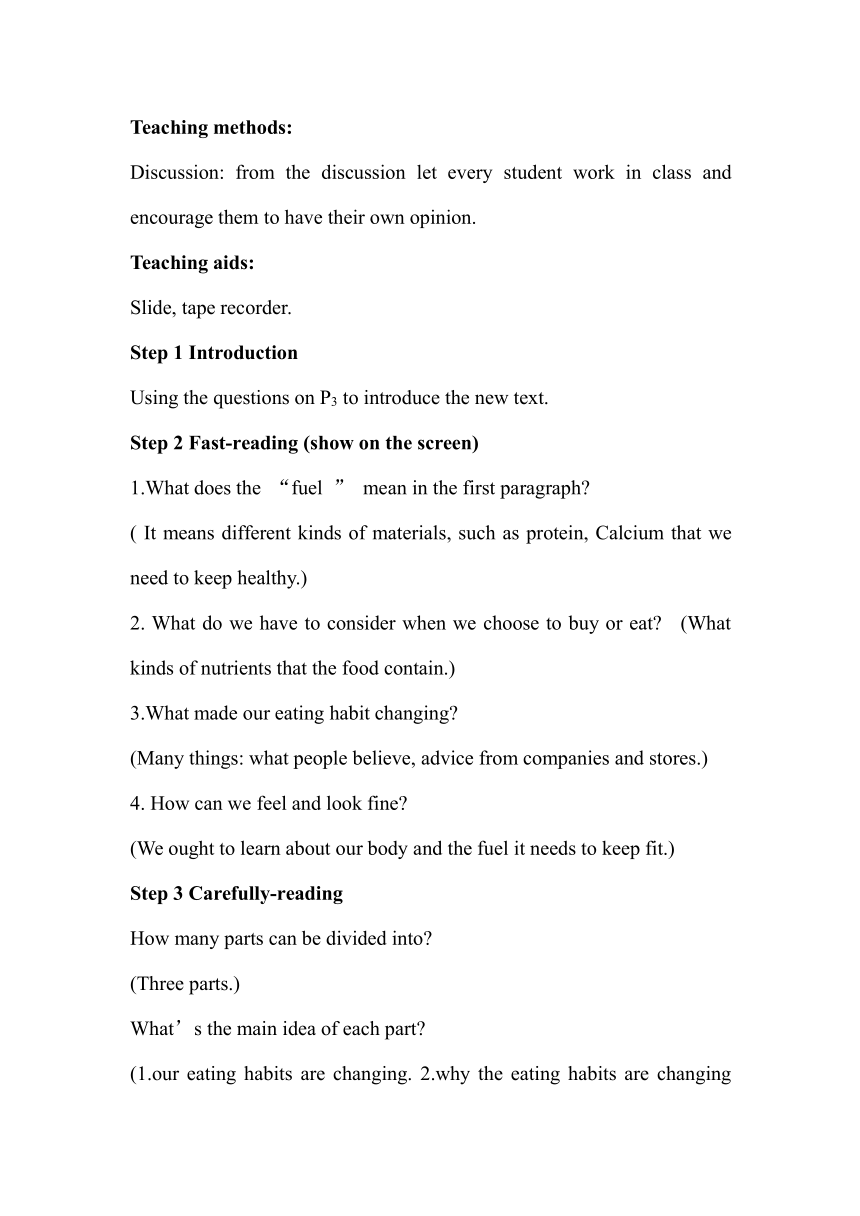
文档简介
Unit 2 Healthy eating
Teaching Aims and Demands
1.Talk about eating habits and health
2..Practise seeing the doctor.
3.Practise giving advice and making suggestions.
4. Use the modal verbs had better, should, ought to
5. Learn some useful cooking terms.
6. Read and write recipes.
l Words and Phrases
stomach , fever , ought , ought to , examine , plenty , plenty of , diet , keep up with , make a right choice , short of , fit , gain , now and then, energy, soft , bar ,fuel ,chemical , balance , tasty , boil, mixture
Useful expressions
In the clinic / seeing a doctor:
What’s wrong with you /What’s the matter with you
Lie down and let me examine you.
Let me have a look.
Where does it hurt
Drink plenty of water and get some rest.
I’ve got a pain here. This place hurts.
There’s something wrong with back/my knee/my arm.
I don’t feel well.
Grammar:
Use of Language:
1. Master the function use of language as defined above.
2. Help the students to finish the tasks of listening, reading, writing, speaking presented in the book and the exercise book through using what the students have learned.
Learn the text about healthy eating. Get the students know about the basic knowledge of how to eat healthily.
Important points:
1. Talk about different kinds of food that one favorites.
2. learn the basic knowledge of healthy eating.
3. learn how to say in the clinic.
4. Grasp the language points and grammar in the text.
Difficult points: The use of modal verbs --- had better, should and ought to.
Teaching aids: computer or slider-projector
Way of Teaching: Communication way of teaching, discussion and group work.
period 1
Teaching aims and demands
1.Talk about eating habits and health
2.Practise seeing the doctor.
3. Practise giving advice and making suggestions.
Main and difficult points
Practise my students’ oral English and make them know what expressions they can use when they see the doctor and try to practice giving advice and making suggestions.
Step 1 Lead in
First show the students some pictures of dishes and so to introduce the topic of this unit.
Step 2Warming-Up
And then show the pictures on their text books and let them to decide what is junk food and what is not.
Here the students may have a short ask and answer in pairs to themselves more engaged in the topic.
Junk foods: Hamburger, Chock late … Healthy foods: rice …
Step 3 Pre-speaking
There are so many foods. And if we do not eat them properly we may be ill because of it. For example in our spring festival sometimes we may have stomachache if we eat too much.. then we have to see a doctor.
Step 4 Speaking
1. Show the example dialogue to students.
2. Play the tape and read after it.
3. Sum up some of the useful expressions in the dialogue and in the form.
4. Show the students the three situations on P2. Then ask the students to prepare a dialogue according to the examples in pairs.
5. Ask several pairs of students to present their dialogues.
6. After that list the useful expressions in their dialogue.
Step 4 Homework
Prepare for the next class.
Collect some menus if possible for the next class.
Step 5 sum up
Record of teaching:
period 2
Teaching aims and demands
1. To improve my students’ reading ability.
2. To be more knowledgeable by reading the passage.
3. Try to form healthy eating habits.
Main points
To improve my students’ reading ability.
Difficult points
1. To improve my students’ reading ability.
2. To be more knowledgeable by reading the passage.
Teaching methods:
Discussion: from the discussion let every student work in class and encourage them to have their own opinion.
Teaching aids:
Slide, tape recorder.
Step 1 Introduction
Using the questions on P3 to introduce the new text.
Step 2 Fast-reading (show on the screen)
1.What does the “fuel ” mean in the first paragraph
( It means different kinds of materials, such as protein, Calcium that we need to keep healthy.)
2. What do we have to consider when we choose to buy or eat (What kinds of nutrients that the food contain.)
3.What made our eating habit changing
(Many things: what people believe, advice from companies and stores.)
4. How can we feel and look fine
(We ought to learn about our body and the fuel it needs to keep fit.)
Step 3 Carefully-reading
How many parts can be divided into
(Three parts.)
What’s the main idea of each part
(1.our eating habits are changing. 2.why the eating habits are changing 3.the best way to develop healthy eating habits.)
Step 4 Discussion
Ask the students to take out their menus and read them carefully. Then discuss what kind of food they want to recommend to their friends or families.
Step 5 Sum up.
Step 6 Homework
Finish the exercise
Step 7 The design of the blackboard.
We are what we eat
Step 8 The record after teaching.
period 3
Teaching aims and demands
1.Have a deeper understanding of the passage.
2.Master some important points of the text.
3. Improve my students’ comprehensive ability.
Main and difficult points
Some important points of the text.
Teaching method:
First T gives some important points. Then let students find out their difficult points and ask some students to answer. If they cannot then T answers it.
Teaching aids:
Slide
Step 1 Revision
Check the homework.
Review what we learnt in last period
Step2 T gives some important points to students.
1.You ought to be careful with fruit.
Ought ( oughtn’t ) to : should(应当,应该)
We ought to respect not only own privacy, but also that of others.
你不该抽那么多烟。
.2 It’s nothing serious.
There is nothing serious with him. He will be ok.
He put everything necessary into his suitcase.
3.Choosing what to eat is no longer as easy as it once was.
No longer (=not … any longer不再)
His neighbour said he no longer lived there.
He is too narrow-minded. I can’t stand him any longer
4. If we want to keep up with the high …,we had better learn to make the ….
You’d better go to bed. Don’t pull that long face. Look at the time!
Step 3 Students tell me some important points and then all the students discuss it ,then draw a conclusion.
Step 4 Sum up
Step 5 Home work
Review the language points and preview grammar
Step 6 The design of blackboard
1. ought (not) to
2. It’s nothing serious.
3. no longer
4. keep up with
5. had better
Step 7 the record after teaching
period 4
Teaching aims and demands
Master modal verbs had better, should, ought to
Main and difficult points: How to use had better, should, ought to to make and giving suggestions
Teaching methods: Talk about making and giving suggestions by using had better, should, ought to and then draw a conclusion. Then do some exercise.
Teaching steps:
Step1 Greeting
Step2 Review the language points
Step 3Grammar
1. First present the students the modal sentences with Modal Verbs and ask the students to make some sentences with them.
Modal Verbs (1)--- had better, should and ought
When you give advice or your opinion about something, you can use had better or had better not.
You had better get some rest. (=you’d better get some rest)
You had better not eat fruit that isn’t ripe.(=you’d better not eat fruit that isn’t ripe)
When you are trying to advise someone about what to do or what not to do, you can use should / ought to or should not / ought not to.
You should / ought to be careful with fruit.
You should not / ought not to eat so much junk food. ( = you shouldn’t / oughtn’t to eat so much junk food.)
Step 4Consolidation
(1) Finish the exercise on P5 and on P74
(2) Check the answers.
(3) Take out a piece of paper with the column “in order to make the students understand when you are giving advice it is better to use some sentences with had better (not), and ought (not) to, should(not). Then read a passage as an example and afterwards list the points you have to pay attention to when you give advice.
1.give advice that will really help the person.
2. be polite and sincere
at last get the students to finish the following practice.
Step 4 Homework
Finish the exercise 3 on P74 in the students’ workbook.
Step 5 The design of the blackboard
Modal Verbs (1)--- had better, should and ought
You should / ought to be careful with fruit.
You should not / ought not to eat so much junk food.
Step 6 The records after teaching
period 5
Teaching aims and demands
1. Be familiar with the text and learn how to make shaomai and chicken roll-ups
2. Know how to write a recipe
3 Write a recipe
Main and difficult points: How to make a recipe
Teaching steps:
Step 1 Revision
Let some students read their reply to the letters on P74.
Step 2 Reading
Read the text on P6 and then get the students to find the main idea of it (Snacks is also important . we need to learn something about snacks and the way to prepare it.)
Step3 How to write a recipe
When you write a recipe, you need to explain what ingredients will be need and how they will be used. You must also be careful to explain each step carefully and in the right order.
1. Start by making a list of all the ingredients also list how much is needed --- a spoonful, a pound etc.
2. Explain what should be done with each ingredient. Use works like chop, peel, slice and dice.
3. Explain which ingredients should be mixed together and how. Use words like stir, mix and add.
4. Explain how the ingredients should be cooked. Use words like boil, steam and fry.
Step 3 Writing
Ask the students to work in pairs to write the recipe for their favourite dish.
We may first give the tips on P7 as a guide.
Step 4 Discussion
First ask the students to read the passage on P75 and then give the following questions as the topic for the students to talk: What is a couch potato
What does one have to pay special attention to in order to keep healthy (food and exercise etc.)
Step: Sum up
Step 5 Homework
Do a general survey in order to learn about the differences between people’s eating habits and try to find which is healthier.
period 6 listening
Teaching aims and demands
1 Improve my students’ listening ability
2. Learn some useful expressions
3. Practise seeing the doctor, giving advice and making suggestions.
Main and difficult points
Improve their listening ability and try to make my students form good eating habits.
Teaching aids: A computer
Teaching methods: First present this part by talking about something of warming up about eating. And then ask my students to do some listening exercise.
Teaching steps
Pre-listening
Greet my students and make them tell me what they have learnt from this unit.
Tell my students something we will learn today and tell them some new words
While-listening
1. Listen to the whole passage and ask some students to tell me what they hear from the text
2 Listen to the part1 and try to finish the first three questions
Ask some students to tell me their answers
3 Listen to the first part again and the Ss check the answers
T give them the correct answers
4. Part2
Do as part1
Post-listening
Sum up
Tell my students that we should form good eating habits in order to be healthy. And then we can make our study well.
Record after this part
Teaching Aims and Demands
1.Talk about eating habits and health
2..Practise seeing the doctor.
3.Practise giving advice and making suggestions.
4. Use the modal verbs had better, should, ought to
5. Learn some useful cooking terms.
6. Read and write recipes.
l Words and Phrases
stomach , fever , ought , ought to , examine , plenty , plenty of , diet , keep up with , make a right choice , short of , fit , gain , now and then, energy, soft , bar ,fuel ,chemical , balance , tasty , boil, mixture
Useful expressions
In the clinic / seeing a doctor:
What’s wrong with you /What’s the matter with you
Lie down and let me examine you.
Let me have a look.
Where does it hurt
Drink plenty of water and get some rest.
I’ve got a pain here. This place hurts.
There’s something wrong with back/my knee/my arm.
I don’t feel well.
Grammar:
Use of Language:
1. Master the function use of language as defined above.
2. Help the students to finish the tasks of listening, reading, writing, speaking presented in the book and the exercise book through using what the students have learned.
Learn the text about healthy eating. Get the students know about the basic knowledge of how to eat healthily.
Important points:
1. Talk about different kinds of food that one favorites.
2. learn the basic knowledge of healthy eating.
3. learn how to say in the clinic.
4. Grasp the language points and grammar in the text.
Difficult points: The use of modal verbs --- had better, should and ought to.
Teaching aids: computer or slider-projector
Way of Teaching: Communication way of teaching, discussion and group work.
period 1
Teaching aims and demands
1.Talk about eating habits and health
2.Practise seeing the doctor.
3. Practise giving advice and making suggestions.
Main and difficult points
Practise my students’ oral English and make them know what expressions they can use when they see the doctor and try to practice giving advice and making suggestions.
Step 1 Lead in
First show the students some pictures of dishes and so to introduce the topic of this unit.
Step 2Warming-Up
And then show the pictures on their text books and let them to decide what is junk food and what is not.
Here the students may have a short ask and answer in pairs to themselves more engaged in the topic.
Junk foods: Hamburger, Chock late … Healthy foods: rice …
Step 3 Pre-speaking
There are so many foods. And if we do not eat them properly we may be ill because of it. For example in our spring festival sometimes we may have stomachache if we eat too much.. then we have to see a doctor.
Step 4 Speaking
1. Show the example dialogue to students.
2. Play the tape and read after it.
3. Sum up some of the useful expressions in the dialogue and in the form.
4. Show the students the three situations on P2. Then ask the students to prepare a dialogue according to the examples in pairs.
5. Ask several pairs of students to present their dialogues.
6. After that list the useful expressions in their dialogue.
Step 4 Homework
Prepare for the next class.
Collect some menus if possible for the next class.
Step 5 sum up
Record of teaching:
period 2
Teaching aims and demands
1. To improve my students’ reading ability.
2. To be more knowledgeable by reading the passage.
3. Try to form healthy eating habits.
Main points
To improve my students’ reading ability.
Difficult points
1. To improve my students’ reading ability.
2. To be more knowledgeable by reading the passage.
Teaching methods:
Discussion: from the discussion let every student work in class and encourage them to have their own opinion.
Teaching aids:
Slide, tape recorder.
Step 1 Introduction
Using the questions on P3 to introduce the new text.
Step 2 Fast-reading (show on the screen)
1.What does the “fuel ” mean in the first paragraph
( It means different kinds of materials, such as protein, Calcium that we need to keep healthy.)
2. What do we have to consider when we choose to buy or eat (What kinds of nutrients that the food contain.)
3.What made our eating habit changing
(Many things: what people believe, advice from companies and stores.)
4. How can we feel and look fine
(We ought to learn about our body and the fuel it needs to keep fit.)
Step 3 Carefully-reading
How many parts can be divided into
(Three parts.)
What’s the main idea of each part
(1.our eating habits are changing. 2.why the eating habits are changing 3.the best way to develop healthy eating habits.)
Step 4 Discussion
Ask the students to take out their menus and read them carefully. Then discuss what kind of food they want to recommend to their friends or families.
Step 5 Sum up.
Step 6 Homework
Finish the exercise
Step 7 The design of the blackboard.
We are what we eat
Step 8 The record after teaching.
period 3
Teaching aims and demands
1.Have a deeper understanding of the passage.
2.Master some important points of the text.
3. Improve my students’ comprehensive ability.
Main and difficult points
Some important points of the text.
Teaching method:
First T gives some important points. Then let students find out their difficult points and ask some students to answer. If they cannot then T answers it.
Teaching aids:
Slide
Step 1 Revision
Check the homework.
Review what we learnt in last period
Step2 T gives some important points to students.
1.You ought to be careful with fruit.
Ought ( oughtn’t ) to : should(应当,应该)
We ought to respect not only own privacy, but also that of others.
你不该抽那么多烟。
.2 It’s nothing serious.
There is nothing serious with him. He will be ok.
He put everything necessary into his suitcase.
3.Choosing what to eat is no longer as easy as it once was.
No longer (=not … any longer不再)
His neighbour said he no longer lived there.
He is too narrow-minded. I can’t stand him any longer
4. If we want to keep up with the high …,we had better learn to make the ….
You’d better go to bed. Don’t pull that long face. Look at the time!
Step 3 Students tell me some important points and then all the students discuss it ,then draw a conclusion.
Step 4 Sum up
Step 5 Home work
Review the language points and preview grammar
Step 6 The design of blackboard
1. ought (not) to
2. It’s nothing serious.
3. no longer
4. keep up with
5. had better
Step 7 the record after teaching
period 4
Teaching aims and demands
Master modal verbs had better, should, ought to
Main and difficult points: How to use had better, should, ought to to make and giving suggestions
Teaching methods: Talk about making and giving suggestions by using had better, should, ought to and then draw a conclusion. Then do some exercise.
Teaching steps:
Step1 Greeting
Step2 Review the language points
Step 3Grammar
1. First present the students the modal sentences with Modal Verbs and ask the students to make some sentences with them.
Modal Verbs (1)--- had better, should and ought
When you give advice or your opinion about something, you can use had better or had better not.
You had better get some rest. (=you’d better get some rest)
You had better not eat fruit that isn’t ripe.(=you’d better not eat fruit that isn’t ripe)
When you are trying to advise someone about what to do or what not to do, you can use should / ought to or should not / ought not to.
You should / ought to be careful with fruit.
You should not / ought not to eat so much junk food. ( = you shouldn’t / oughtn’t to eat so much junk food.)
Step 4Consolidation
(1) Finish the exercise on P5 and on P74
(2) Check the answers.
(3) Take out a piece of paper with the column “in order to make the students understand when you are giving advice it is better to use some sentences with had better (not), and ought (not) to, should(not). Then read a passage as an example and afterwards list the points you have to pay attention to when you give advice.
1.give advice that will really help the person.
2. be polite and sincere
at last get the students to finish the following practice.
Step 4 Homework
Finish the exercise 3 on P74 in the students’ workbook.
Step 5 The design of the blackboard
Modal Verbs (1)--- had better, should and ought
You should / ought to be careful with fruit.
You should not / ought not to eat so much junk food.
Step 6 The records after teaching
period 5
Teaching aims and demands
1. Be familiar with the text and learn how to make shaomai and chicken roll-ups
2. Know how to write a recipe
3 Write a recipe
Main and difficult points: How to make a recipe
Teaching steps:
Step 1 Revision
Let some students read their reply to the letters on P74.
Step 2 Reading
Read the text on P6 and then get the students to find the main idea of it (Snacks is also important . we need to learn something about snacks and the way to prepare it.)
Step3 How to write a recipe
When you write a recipe, you need to explain what ingredients will be need and how they will be used. You must also be careful to explain each step carefully and in the right order.
1. Start by making a list of all the ingredients also list how much is needed --- a spoonful, a pound etc.
2. Explain what should be done with each ingredient. Use works like chop, peel, slice and dice.
3. Explain which ingredients should be mixed together and how. Use words like stir, mix and add.
4. Explain how the ingredients should be cooked. Use words like boil, steam and fry.
Step 3 Writing
Ask the students to work in pairs to write the recipe for their favourite dish.
We may first give the tips on P7 as a guide.
Step 4 Discussion
First ask the students to read the passage on P75 and then give the following questions as the topic for the students to talk: What is a couch potato
What does one have to pay special attention to in order to keep healthy (food and exercise etc.)
Step: Sum up
Step 5 Homework
Do a general survey in order to learn about the differences between people’s eating habits and try to find which is healthier.
period 6 listening
Teaching aims and demands
1 Improve my students’ listening ability
2. Learn some useful expressions
3. Practise seeing the doctor, giving advice and making suggestions.
Main and difficult points
Improve their listening ability and try to make my students form good eating habits.
Teaching aids: A computer
Teaching methods: First present this part by talking about something of warming up about eating. And then ask my students to do some listening exercise.
Teaching steps
Pre-listening
Greet my students and make them tell me what they have learnt from this unit.
Tell my students something we will learn today and tell them some new words
While-listening
1. Listen to the whole passage and ask some students to tell me what they hear from the text
2 Listen to the part1 and try to finish the first three questions
Ask some students to tell me their answers
3 Listen to the first part again and the Ss check the answers
T give them the correct answers
4. Part2
Do as part1
Post-listening
Sum up
Tell my students that we should form good eating habits in order to be healthy. And then we can make our study well.
Record after this part
